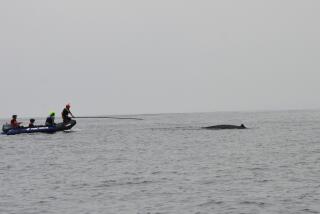Report: Sonar May Have Caused Whale Stranding
SAN DIEGO — The unusual stranding of 150 melon-headed whales in a shallow bay off the island of Kauai in 2004 could have been caused by the animals being spooked by the use of sonar by Navy ships, a federal agency reported Thursday.
“We can find no other cause for this event -- given the fact there are many things we don’t know,” said Teri Rowles, a marine mammal veterinarian with the Fisheries Service of the National Oceanic and Atmospheric Administration.
Still, without more information about the behavior of melon-headed whales, their reaction to noise and their location when the ships started using sonar, no final conclusion about the cause of the stranding can be made, the agency’s report said.
The report brought an immediate call from environmental activists for the Navy to stop using so-called medium-frequency sonar in places where marine mammals are known to congregate.
“It’s time for the Navy to stop this needless infliction of harm,” said Michael Jasny, a senior consultant with the Natural Resources Defense Council.
But a Navy spokesman said the service “fully concurs” with the report’s finding that no definitive link has been established. “There is no evidence of sonar causing harm to any marine mammals,” said Lt. William Marks.
The whales were successfully herded back into the ocean by volunteers, although one calf that was already sickly died.
One theory is that the whales were fleeing the sonar noise when they ended up in Kauai’s Hanalei Bay. Melon-headed whales prefer deep waters, so their presence near the shore was cause for alarm.
The stranding occurred during an exercise involving 40 ships and 100 aircraft from seven nations that the U.S. Navy calls Rim of the Pacific and has held every other year since 1968. A similar exercise is planned for June 26 to July 28.
With the melon-headed whale controversy as backdrop, the Navy applied for an “incidental harassment authorization” permit from NOAA for this year’s exercise. The agency has tentatively issued a permit, pending a 30-day period in which the public can offer objections.
The Navy has tentatively agreed to a series of mitigation measures, including additional spotters to watch for marine mammals and a promise to lower the decibel level if whales or other animals are spotted. The Natural Resource Defense Council, however, says those measures are inadequate.
The report is the latest skirmish between the Navy and environmentalists over whether sonar hurts marine mammals. The controversy has flared as part of the Navy’s desire to establish a sonar training site off North Carolina.
For the Navy, Rim of the Pacific is an opportunity to train with allies. One training exercise involves using sonar to locate submarines playing the role of enemies attempting to quietly position themselves for a strike.
Navy officials see a threat from ultra-quiet diesel submarines being acquired by a variety of nations, including Iran, China and North Korea. Diesel submarines are quieter -- and thus more stealthy -- than the nuclear-powered submarines favored by the Soviet navy during the Cold War.
The undersea geography in the Hawaiian island chain contains a number of constricted channels or “chokepoints” like those in the Strait of Hormuz, the narrow opening of the Persian Gulf. For that reason, military officials say Hawaii is an ideal setting for training in anti-submarine warfare.
More to Read
Sign up for Essential California
The most important California stories and recommendations in your inbox every morning.
You may occasionally receive promotional content from the Los Angeles Times.










